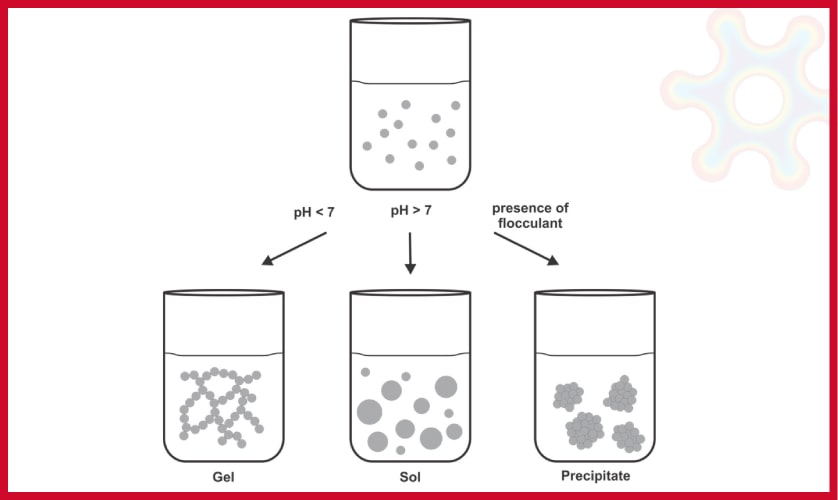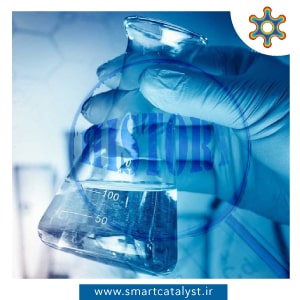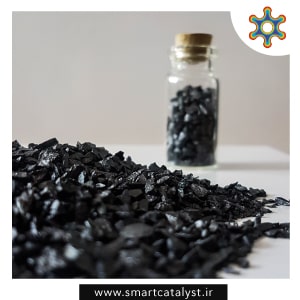Silica is a clear, slightly opaque aqueous solution of silicic acid and is prepared with 30% colloidal silicon dioxide (SiO2). The possibility of using insoluble and anhydrous silicon dioxide as “aqueous solution” and particle size from 5 nm to 100 nm is obtained by colloidal distribution. Typically, during the preparation process, they have a distribution of fine particle size, high density, low viscosity and no distinguishable distinction.
| Name | Quality | Molecular Weight | pH | Density | Size | Info |
| Silica sol | 100 | 60.08 | 9.1 | 1.2 g / ml at 25 ° C | 5-100 Nanometer | Solvent free, low odor |
The surface of colloidal silica in contact with water is covered by siloxane bonds (≡Si–O–Si≡) and silanol groups (≡Si–OH). This makes colloidal silica hydrophilic and capable of forming multiple hydrogen bonds. Colloidal silicates are often prepared in a multi-step process in which the alkaline solution of the silicate is partially neutralized, leading to the formation of silica nuclei. The subunits of colloidal silica particles are usually in the range of 1 to 5 nm. Whether or not these subunits are connected depends on the polymerization conditions. The initial acidification of the water glass solution (sodium silicate) yields Si(OH)4.

Silicic acid can be in the form of monomers or in the form of low molecular weight polymer units. This monomeric Si(OH)4 is not separated or obtained as a concentrated solution without polymerization, so it is not a functional form for use in catalytic slurries for industrial application. Failure to remove electrolytes can also affect its inefficiency in the industry. The remaining electrolytes increase the ionic strength of the solution, leading to instability, followed by the formation of an early silica gel. The preferred form of silicic acid for use in our preparation is polysilicic acid (PSA). The term polysilicic acid generally refers to those silicic acids that are formed in the pH range of 1-4 and are partially polymerized.
Polysilicic acid made from discrete particles 1.5 to 4 nm in diameter may be partially or completely polymerized in the form of three-dimensional chains and lattices. When the polysilicic acid solution is exposed to alkaline conditions, it rapidly transforms into colloidal silica particles larger than 4-5 nm in diameter. The term polysilicic acid is justified when silica has a very high specific surface area and contains a high proportion of SiOH groups per unit weight of silica. In the end, 100 nm silica sol is justified for us.
.
| SILICA | SILICON |
| Silica is a compound made out of silicon and oxygen atoms | Silicon is an element found in the earth crust |
| A composite element | A single element |
| Cannot conduct electricity | Can conduct electricity |
| Can occur as a pure compound | Does not occur alone in nature |
| Crystal structure is very hard | Crystal structure is brittle |
| Melting point is about 1713 degrees Celcius | Melting point is about 1414 degrees Celcius |
Preparation method of silica sol
PSA solutions can be obtained by adding a thin stream of sodium silicate solution with a SiO2: Na2O ratio of 3.25: 1.0 in a severely stirred solution of H2SO4 at 0-58 °C. This part will end when the pH reaches about 1.7. After that, deionization of sodium silicate solution with ion exchange resin is performed at room temperature. Sodium silicate is then added to the system to increase the particle size as well as the stability of silicic acid. This increase is done until the pH of the solution reaches about 7. Then, in order to reach the desired particle size, the solution is mixed with vigorous mixing, and then again by adding sodium silicate, the pH of the solution is brought to about 10. At this stage, silica sol is formed, but this silica sol is not cost-effective for storage and transportation due to its low concentration, so to concentrate the solution, hot steam or ultrafiltration method is used to reach a concentration of 30 to 35%.
FAQ
Silica solutions are colloidal, solvent-free, low-odor colloidal solutions containing 30% amorphous silicon dioxide (SiO2) with particle sizes from 5 nm to 100 nm.
Silica cell has been increasingly used in a variety of applications in several different fields, one of which is injection molding. Injection of layers can have different purposes such as stabilizing loose sand, preventing leakage and so on.
Health effects
Silica dust particles are fine, more than 100 times smaller than the sand you see on beaches. If you are exposed to silica dust at work, this can cause many problems for your health. Inhalation of crystalline silica dust increases the risk of lung cancer, chronic obstructive pulmonary disease (COPD) and liver and kidney disease. It can also cause disability or even death in severe cases.





